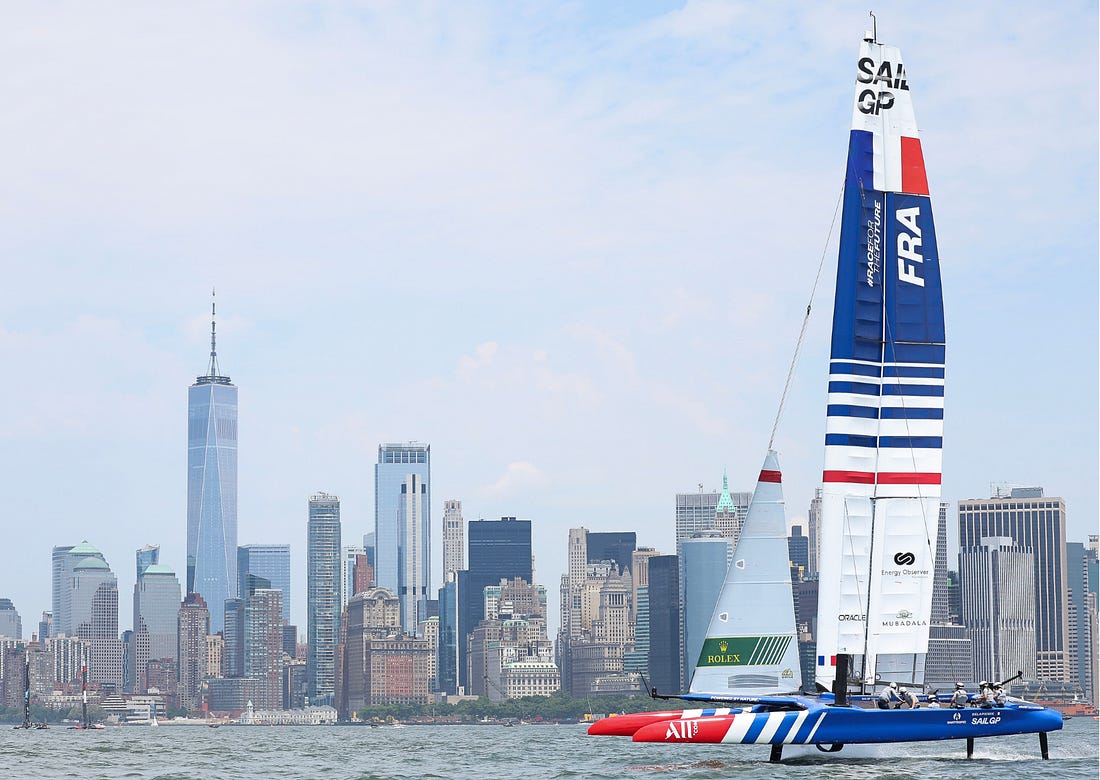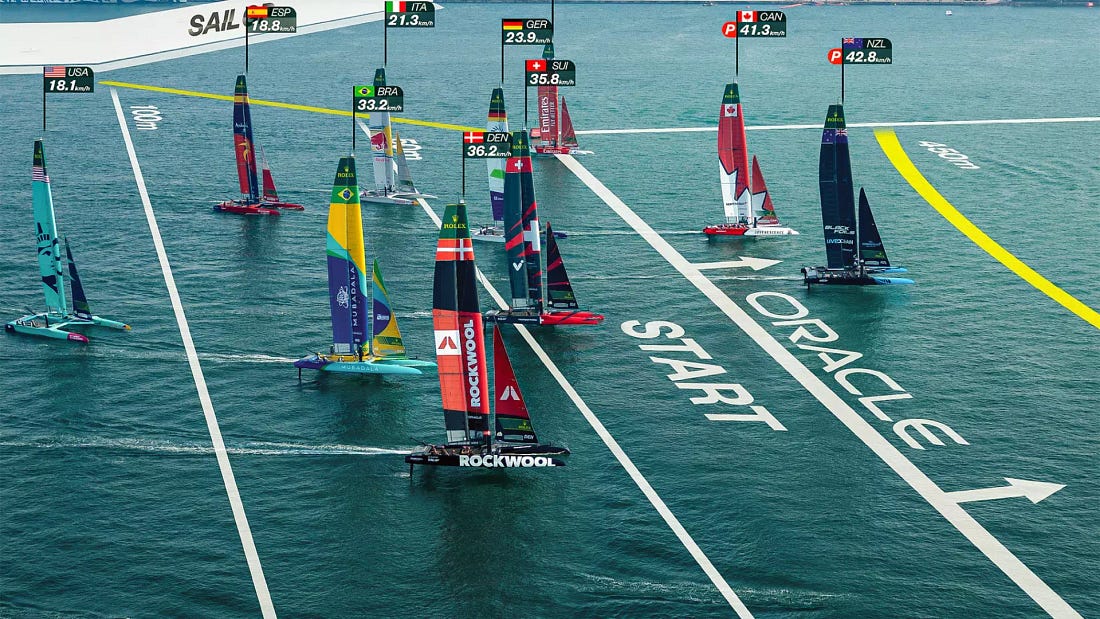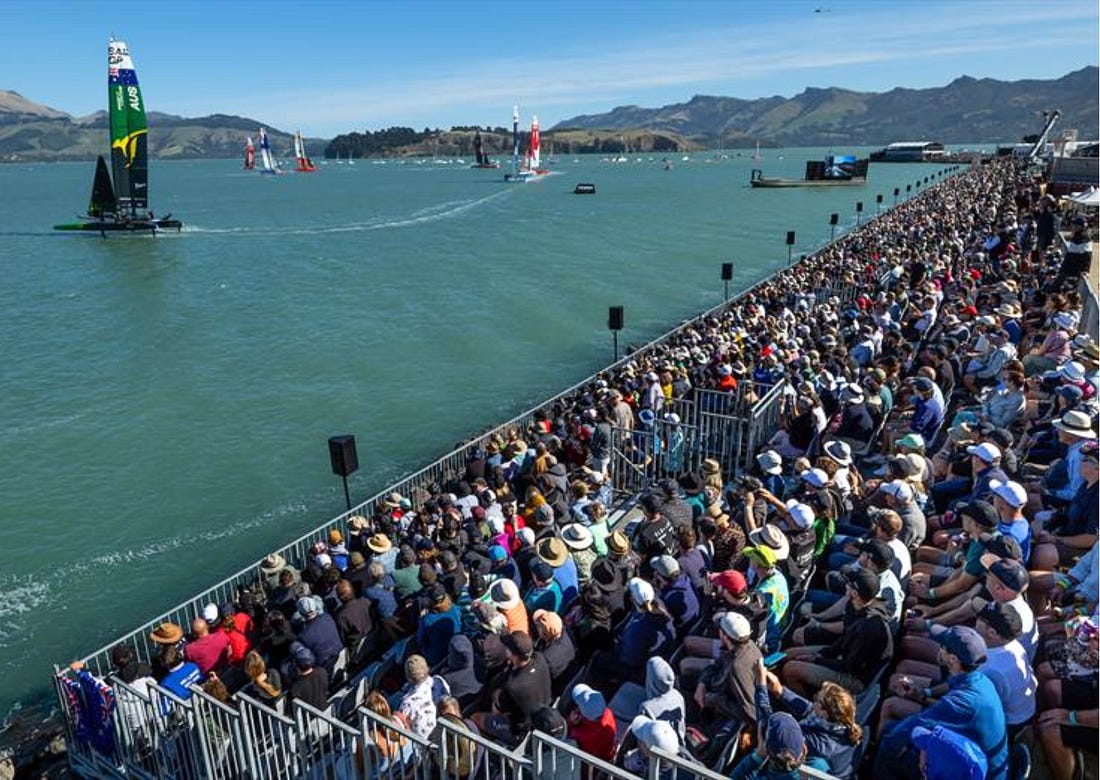The Rise of SailGP: How a Niche Hobby Turned Into a Global Powerhouse
The Rise of SailGP: How a Niche Hobby Turned Into a Global PowerhouseSailGP was supposed to be a billionaire’s vanity project. Instead, it’s become one of the world’s fastest-growing sports — with $2 million prizes, high-tech catamarans, and global events rivaling F1.
Twelve 50-foot catamarans will race around New York City this weekend. They’ll reach speeds over 60 mph while thousands of fans watch on shore nearby, enjoying a festival-like atmosphere complete with food, drinks, music, and various experiences. As the catamarans fly by iconic monuments like the Statue of Liberty, over 800 sensors on each boat will transmit 270,000 data points per second. Fans will see everything from the strain on the wingsail to the crew’s heartbeat in real time. Augmented reality systems will project racecourse boundaries on the screen for viewers at home. Drones and chase-cam boats equipped with gyro-stabilized 4K cameras will provide dramatic angles, often overlaid with virtual trails behind each boat indicating their path and speed. Each of the six races this weekend will last only 15 minutes, but millions of viewers will watch as if they are on board with the crew. The technology is so advanced that new viewers often feel like they are piloting a fighter jet or driving a Formula 1 car. That’s intentional. This technology is one of the primary reasons SailGP is now one of the world’s fastest-growing sports leagues. Founded in 2018 by Oracle co-founder Larry Ellison and Olympic yachtsman Sir Russell Coutts, SailGP is rewriting the playbook on emerging sports. Over the last seven years, the international sailing championship has gone from a niche hobby watched by sailing enthusiasts to a spectacle every major city wants to host. Think of SailGP as the F1 of sailing. Twelve teams travel all around the world competing in races to win millions of dollars in prize money. From the waters of Sydney Harbour and San Francisco Bay to Rio de Janeiro and even Switzerland’s landlocked Lake Geneva, SailGP will host races on five continents this year alone. Each Grand Prix event is a two-day regatta with a series of races. Teams are awarded points based on their finishing position in a handful of 15-minute, sprint-style races each weekend. The top three teams then move on to a winner-take-all final round, with this year’s season-long champion taking home a $2 million first-place prize. But here’s the most interesting part: Unlike Formula 1, where teams with the most money and resources routinely win races by building the fastest cars, every SailGP team uses the same equipment. These 50-foot hydrofoiling sailboats rise out of the water at top speeds and even the playing field, turning each race into a meritocracy. “We’ve had five different winners for the first five Grand Prixs this season. So it gives you a sense of how tight of a margin these teams are operating within,” SailGP’s Chief Revenue Officer Ben Johnson tells me. SailGP is such a fascinating business because it should have never become successful. Many people thought it would be a money-losing endeavor for Larry Ellison. Sure, he’s got plenty of cash, but sailing is a niche sport with a ton of intricacies. The average person doesn’t know how to operate a sailboat, much less have an interest in watching others do it. It was going to be an uphill battle, and Ellison knew that. But just seven years removed from launch, SailGP has done the impossible. The league has now expanded from six teams to 12 teams and five races to 13 races. These races will be held on five continents in places like Dubai, Sydney, Los Angeles, Rio de Janeiro, and Abu Dhabi, and a dozen countries are now represented on each Grand Prix weekend, including Australia, Canada, Great Britain, France, Germany, Brazil, New Zealand, Italy, Denmark, Spain, Switzerland, and the United States. This multi-continent schedule is incredibly difficult logistically. Given SailGP’s commitment to sustainability as a nature sport, they don’t ship any of the equipment by air. Every single sailboat is transported from city to city by boats, trains, and cars. Many of the SailGP teams are privately owned. Valuations have quickly surpassed $50 million, and celebrity owners such as Kylian Mbappé, Deontay Wilder, Jozy Altidore, Anne Hathaway, Gary Vaynerchuk, and DeAndre Hopkins have invested in teams. SailGP is not yet profitable, but that’s okay. Instead of sucking cash out of the business, Ellison and his partners have reinvested in growth. SailGP now has one of the most diverse revenue streams in sports. They collect money from team sales and host fees. Companies like Rolex and Emirates spend millions each year on SailGP’s sponsorship inventory. They have broadcast deals in over 200 countries and territories worldwide, and that’s without counting merchandise, ticket sales, and licensing deals. “We’ve more than doubled our annual revenue each year. We haven’t released specific figures, but we are ahead of where we thought we’d be five years into operating this league with continued material investment in things that we think add value back to the racing product, to the fans. What we’re looking at today is very simplistic. It’s total revenue growth and total awareness,” says Johnson. Huddle Up is a reader-supported publication. To receive new posts and support my work, consider becoming a free or paid subscriber. SailGP has rewritten the playbook through innovation. While fans on social media criticize most sports leagues for having too many commercial breaks or poor commentary, SailGP has built the best TV production in sports. It’s not hyperbole to say that the things SailGP is doing today, every league will eventually be doing in the future. Trust me, just watch the event in New York City this weekend. You’ll agree. SailGP initially focused on getting its races on as many free-to-air TV stations as possible, even if those networks were not willing to pay them a broadcast fee. This is a similar strategy to what Formula 1 employed by giving its U.S. broadcast rights away to ESPN for free in 2017, and it has worked just as well for SailGP as it did for F1. SailGP is now broadcast across the Americas, Europe, Africa, and Asia, but the league’s U.S. partnership with CBS Sports has been a game-changer. Select races have aired on the CBS broadcast channel on weekend afternoons, sometimes strategically placed after NFL football games to capture a large crossover audience. In October 2023, the post-NFL positioning led to 1.78 million viewers watching the Spain Sail Grand Prix in Cádiz — the largest audience for a sailing event in over 30 years. In addition to historic media rights coverage, SailGP has secured sponsorship from some of the world’s most prestigious brands. Rolex recently signed a 10-year deal as a title sponsor after losing its F1 deal to LVMH’s TAG Heuer. Ellison’s Oracle handles all the data, but you’ll also see names like J.P. Morgan, Emirates, KPMG, Land Rover, Helly Hansen, and Accor Hotels spread across SailGP’s hospitality and catamarans. SailGP’s sponsorship model has evolved from relying on Ellison’s Oracle and a few early partners to a diverse portfolio of global sponsors and localized team deals. This influx of cash has been critical in offsetting event costs and validating the league’s business model, proving that a standalone sailing series can attract corporate backing. SailGP’s ability to attract TV audiences and sign sponsorship deals has transformed the business financially. Annual operating costs remain high due to the significant expenses incurred for logistics and production at each event, which cost millions. However, SailGP is expected to generate $100 million to $150 million in revenue this season, a sizable increase from the $10 million it generated in its debut season in 2019. As of 2025, 10 of the 12 teams are privately owned or operated. Most of these teams were acquired for $40 million to $60 million, with $50 million now serving as the de facto floor on new team sales. Each team sale not only provides an influx of cash — new investors pay the fee and assume $10 million in annual operating costs — but they also validate the league’s worth through increasingly higher franchise valuations. “We’ve put a [$10 million] cost cap on the teams so they know what they’re signing up for from an operations perspective. And they’ve got a very simplistic model compared to other sports businesses in terms of sponsorship, host city fees, media rights, things that they are able to turn on and activate in their local markets,” Johnson tells me. Endeavor, the global sports and entertainment company, purchased a minority stake in SailGP at a valuation of $200 million after its first season. The company’s valuation is much higher today, but that was a pivotal moment. It injected capital into the business but also brought expertise in media rights, sponsorship sales, and marketing. “There are definitely [SailGP] teams that are profitable early on in their existence, which for us is sort of a validator, both the model, but also finding the right owners that have that shared understanding of what they want to build,” says Johnson. SailGP has now entered the conversation as a commercially viable top global sports league. A record 25,000 fans attended the most recent SailGP event in New Zealand. The 2025 race in Sydney reached over 21 million viewers worldwide. In the U.S., SailGP has agreed to a historic broadcast agreement with CBS, featuring 54 hours of SailGP coverage on its networks this season. And for the first time, DraftKings customers will be able to bet on a SailGP race this weekend in New York City. Even crazier, SailGP is now commanding six figures for its typical hosting fee, with Auckland, New Zealand, paying over $1 million to host a Grand Prix this past January. SailGP still has a long way to go if it wants to match Formula 1’s global appeal and commercial success. But don’t count them out. In just seven years, they’ve built a high-speed, data-driven, globally distributed sports league with six-figure hosting fees, celebrity team owners, and a growing media presence on major U.S. networks. Now, with a $150 million revenue runway, a slate of iconic host cities, and live betting rolling out through DraftKings, SailGP isn’t just sailing — it’s accelerating. And if you think a sailing league can’t be the next big thing in global sports, just watch this weekend’s race in New York. You might change your mind. If you enjoyed this breakdown, share it with your friends. Huddle Up is a reader-supported publication. To receive new posts and support my work, consider becoming a free or paid subscriber. You’re currently a free subscriber to Huddle Up. For the full experience, upgrade your subscription.
© 2025 |



